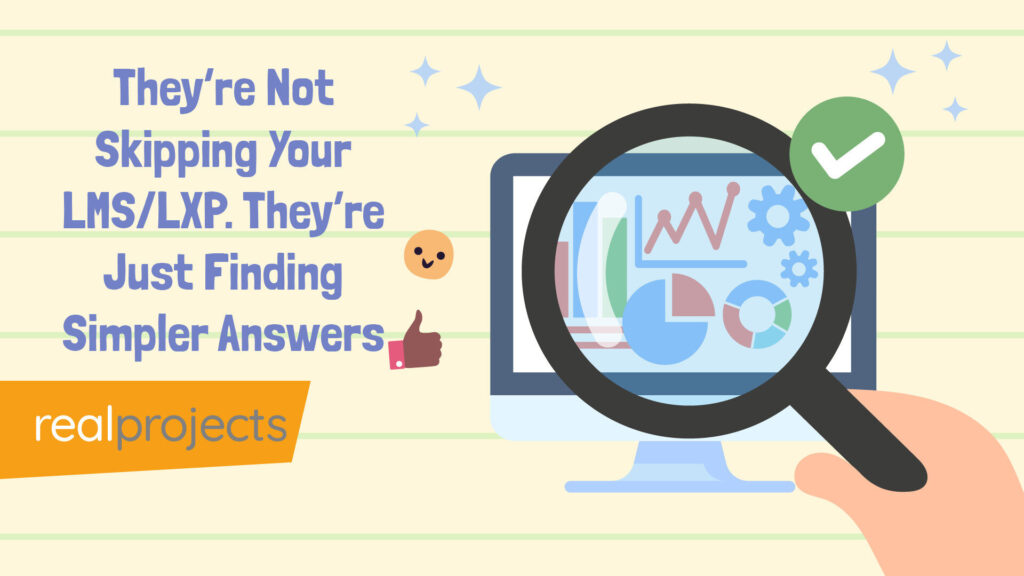Have you an L&D Leaders that has been involved in a project that has started with “We just need a new LMS”?
The LMS market is now massive with vendors available around the world, with LMS platforms available for all sectors and every type of functionality that you can imagine.
You wouldn’t be the first person in this position as well, but the reality is swapping out your LMS might solve yesterday’s problems, not tomorrow’s.
The learning landscape is shifting quickly, and the numbers tell the story. The number of elearning companies offering LMS platforms is continuing to develop.
- The global LMS market is set to grow from $27.09 billion in 2025 to $82.00 billion by 2032 (a 17.1% CAGR), Fortune Business Insights, 2024.
- 81% of employers globally used skills-based hiring in 2024, up from 73% in 2023, TestGorilla, 2024.
- In the UK alone, 84% of companies adopted skills-based hiring practices, TestGorilla, 2024.
- 90% of English businesses report skills shortages, with 32% of shortages in entry-level roles, The Times, 2024.
- 7 out of 8 LMS buying criteria typically come directly from vendors themselves, Brandon Hall Group, 2023.
Against that backdrop, the question isn’t whether you need a change, it’s how you go about selecting an LMS that will actually deliver meaningful business results.
Why a Modern Digital Platform Matters
A lot has changed since the first LMS hit the market, and things continue to move. You might read about the end of the LMS – but the market is growing and LMS platforms continue to develop and respond to customer requirements.
Skills-based learning, AI-driven personalisation, and real collaboration aren’t optional anymore, these are features that you’ll see in many LMS platforms.
If you are involved in the procurement process these are the things you need to consider:
- Why do you want to change platforms?
- What business goals are you trying to meet?
- Can your current system genuinely help you get there?
If your LMS feels like a system stuck in the past, it’s probably slowing you down.
Skills-based strategies are no longer future thinking, they’re happening now. And if your platform can’t support them, you’re already behind.
Crucially, learning engagement isn’t a vanity metric. If people aren’t using your platform, if they aren’t engaging, growing, and applying what they learn.
Engagement is a measure of whether your platform is genuinely adding value, and it needs designing in from day one.
What Is a Skills-Based Organisation?
Where once we focused on broad competencies, businesses today are honing in on specific, measurable skills. Not a theoretical shift, it’s a practical one, and sectors like nuclear energy and manufacturing have been doing it for years because precision matters.
Modern platforms must not only track skills but also show clear, visible progress through tools like spider charts, self-assessments, and manager reviews. Data matters.
It’s about making skills gaps visible and manageable, so they can be closed with purpose.
Build Your Learning Strategy Before You Choose Your Platform
Choosing a platform before you know where you’re heading is a mistake.
Before selecting an LMS, have you thought about:
- How are you planning to engage your learners?
- What types of content will actually work? Video, text, audio, microlearning?
- How will what you’re building support your business goals, not just learning targets?
If you’re not building with engagement in mind, you’ll be setting yourself up for low usage.
Curation matters Many platforms flood users with choices, thirty courses on the same subject. You need to provide playlists, guides and clear categories.
Don’t just dump content into a platform and expect people to find it.
Check that the search function also works – nothing is more frustrating than a free text search that doesn’t work.
Smart platforms help you be ruthless about surfacing what matters, making learning manageable and actionable.
What a Modern Digital Learning Platform Should Include
You’re not just looking for an LMS, you’re looking for a platform that does more. And a platform that supports your business.
It should offer:
- LMS and LXP functionality combined
- Skills engines that track, assess, and close real gaps
- Built-in AI (proper AI, not just marketing noise)
- Collaboration tools that work
- Content curation built in
- Seamless integration with your systems
Modern learning platforms need to support a mix of formats. Modern learning means offering structured courses, informal video, podcasts, and bite-sized resources, all working together. Learners expect the same ease they get outside work.
Learners are now getting access to range of modern topics and content elearning objects. The platform that you are using should be providing up to date, innovative, mobile ready and content from the very best content providers. Alongside this you should be getting real-time data that you can share with your leadership team – L&D needs to know about LMS data storytelling.
Security shouldn’t be a concern if you’re working with the right partners. Modern platforms are GDPR-compliant, meet strict UK data protection standards, and can provide penetration testing reports.
And don’t fall into the trap of treating AI like an add-on.
Proper platforms embed AI at the foundation, using it to personalise learning journeys, identify gaps, and surface insights that drive real business outcomes.
AI functionality is more than just a well branded set of AI prompts or search engines. Several LMS tools are also including elearning development tools, either as part of AI integration or standalone development tools.
Buyer Beware: The Pitfalls of Platform Selection
According to Brandon Hall research, seven out of eight LMS buying criteria often come straight from the vendors themselves. This isn’t really independent advice.
- If you want to avoid painful mistakes when selecting an LMS:
- Always get a sandbox or pilot, not just a shiny demo. You need to have time to ensure that the LMS provide the functionality that you need
- Insist on proper customer support during testing.
- Ask for additional references, not just the ones they pick for you.
- Test the critical functionality yourself.
- If promises sound too good to be true, get legal advice early.
And measure success by something more meaningful than number of users.
The right platform should connect to your KPIs. These might include employee retention, internal mobility, onboarding speed, and skills growth. Look for platforms that make it easy to surface and track this kind of data, it might include integration with tools like Power BI.
Platforms that make it easy for people to share knowledge, learn from peers, and connect across departments build better engagement, and build better skills pipelines.
Build for the Future, Not the Past
The right platform is already out there, if you know what you’re looking for. If you don’t know what you need then it’s time to build a specification before you enter the market. Don’t just go into the procurement process without understanding what you need and what you don’t need.
Choose a platform that will help your organisation build skills, deliver value, and move faster than the competition. With all this considered, if you have a very simple requirement which is deploying content to a small number of people, there is still an option available to you.
Ensure that you don’t over-engineer the solution that you go with. The future of learning isn’t slowing down; ensure that you and your organisation and ready.
Questions
Q: Which factors must be considered in choosing an LMS?
A: Look at skills tracking, AI capabilities, engagement tools, content curation, system integration, and security standards. Check if the platform supports your business goals, not just training needs.
Q: How do I choose the right LMS?
A: Start by defining your learning strategy and business goals. List your requirements like skills engines and AI. Test platforms yourself, request a sandbox trial, and speak to real customers, not just vendor-selected references.
Q: How will you determine the factors and how will you go about implementing the LMS?
A: First, map your goals to needed features like skills tracking and collaboration. Run a pilot programme to test real performance. Plan change management early to support users during rollout, focusing on engagement and adoption.
Q: What factors influence the success of LMS use?
A: Success depends on clear goals, user engagement, regular updates, skills alignment, seamless integration, and leadership support. Platforms with high usage and strong skills tracking perform better over time.



